ASUS Eee PC: Laptop, UMPC, or Something Else?
by Jarred Walton on November 30, 2007 4:00 AM EST- Posted in
- Laptops
Scalpel, Please...
 |
The first area you can access - voiding your warranty! - is on the bottom of the laptop. Here you will find a single DDR2 SO-DIMM slot, which on this model comes fitted with 512MB of memory. Above the SO-DIMM slot is a mini PCI slot, at least on the version we received. We have seen information circulating on the Internet that indicates ASUS may have decided to remove the mini PCI slot on later versions; if that's important to you, you will want to do additional research.
 |
Note that there are rumors that the cost reduced version of the Eee PC 4G, the Eee PC 4G Surf, does not have the upgradable memory - there are conflicting reports, so we recommend double-checking before making any purchase. In addition, the 4G Surf lacks the microphone and webcam and it has a smaller battery - 4400 mAh instead of 5200 mAh.
We are rather disappointed that ASUS chose to void the warranty if any user decides to upgrade their memory (though whether they can enforce this remains to be seen). We expect them to release a model in the future with 1GB of RAM, and we know a model with 8GB of solid-state storage is in the works. Still, upgrading your memory is a simple and painless operation that users are capable of doing without damaging anything. Anyway, since we've already voided our "warranty" we might as well continue taking this thing apart.
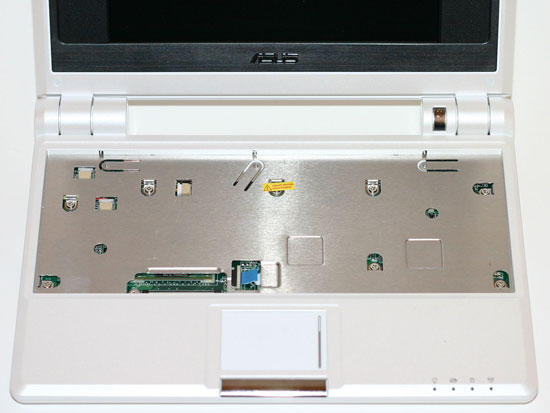 |
The first step is to remove the keyboard; three metal prongs along the top edge hold it in place, and we used a small screwdriver to help with this process. Like all laptop keyboards, a flat data ribbon connects to the motherboard. You'll need to disconnect this in order to continue the dissection process. There's no reason to do so, as the internal components aren't upgradable, but we like taking things apart.
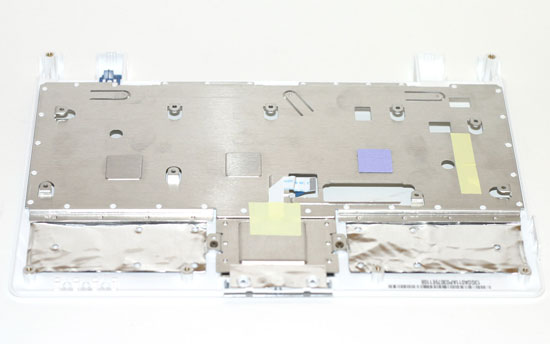 |
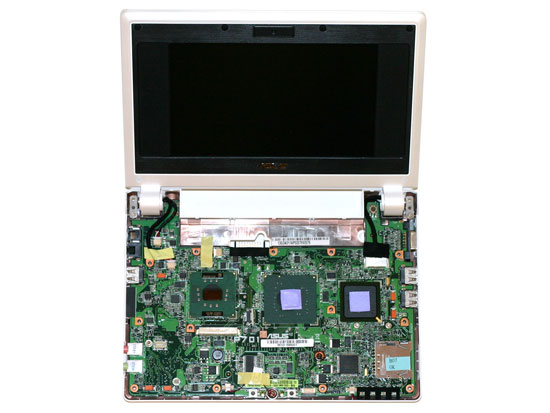 |
Getting at the motherboard proves to be more difficult than usual. Four screws on the bottom and eight screws underneath the keyboard secure the top panel. Besides these 12 screws, however, there are also plastic tabs around the edges that hold the top panel in place. With some patience, a small flat head screwdriver, and some poking and prodding we were able to remove this panel, which also serves as something of a heatsink. We also had to disconnect the small ribbon cable for the touchpad. With that accomplished, we get a nice view of the densely packed motherboard.
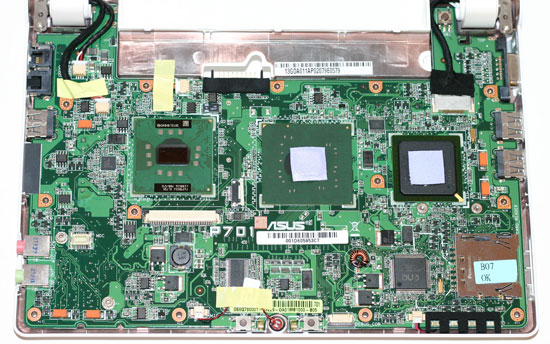 |
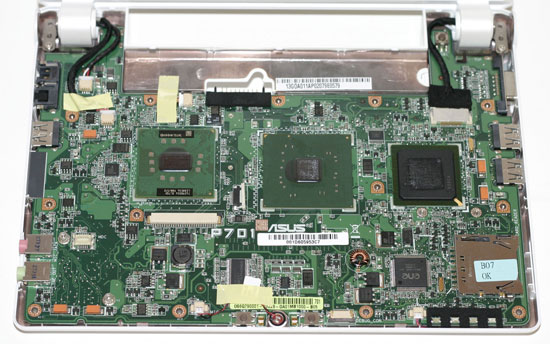 |
Taking a closer look at the motherboard, and removing the heat transfer pads from the middle and right chips, we get to the heart of the Eee PC. The left chip is a 900MHz Celeron M processor, based on the Dothan core with 512K of cache. As reported elsewhere, ASUS underclocks the chip to 630MHz with a 70MHz front side bus. ASUS likely does this to keep temperatures and power requirements in check, although this may change in the future. The center and right chips are the Northbridge and Southbridge.
The center chip is unmarked, but the other two chips are copyright 2003. It's too bad ASUS wasn't able to use a single System-on-a-Chip design; something manufactured using a 45nm process could easily reduce power requirements and improve performance, were such a chip available. Both AMD and Intel are working on such designs, though perhaps it was simply cheaper for ASUS to use old surplus microchips.
If you didn't notice, the flash memory that serves as the main storage is not visible. This should be on the other side of the motherboard, but after some initial attempts at removing the motherboard from the case, we decided discretion was the better course of action. Again, as seen in the above images, there are no user upgradable parts inside anyway.










36 Comments
View All Comments
rhangman - Friday, December 14, 2007 - link
If you are going to compare, then surely a Via Nanobook based solution would be the way to go.http://www.via.com.tw/en/initiatives/spearhead/nan...">http://www.via.com.tw/en/initiatives/spearhead/nan...
Same sized screen/resolution.
Faster clocked chip.
Longer battery life.
Larger storage.
Lighter.
Very similar dimentions.
You also get MPEG-2, MPEG-4, WMV9 HD acceleration, although only with via's poorly implimented drivers and applications under Linux. Openchrome should at least add MPEG-2 support eventually though.
The Asus is I think better looking and cheaper though.
http://www.viagallery.com/index.php?option=com_fli...">http://www.viagallery.com/index.php?opt...s&Se...
Schugy - Monday, December 3, 2007 - link
I would by any other cheap subnotebook with an Athlon 64 2000+ (8W TDP), Radeon Xpress 1250 and a more open Ubuntu Mobile on it.PCTC2 - Monday, December 3, 2007 - link
1) You can modify the GUI to include a start button to access a lot more features on the EeePC by changing the file value of TaskBarShowStartMenu from 0 to 1 in the directory /etc/X11/icewm2) A 10" version with 16GB of SSD space is rumored to be in development for mid-late next year.
I say chuck Xandros and put Ubuntu on it.
PCTC2 - Monday, December 3, 2007 - link
Just kidding about the 10" version. Just a rumor that has now been proven to be false. My b.krwilsonn - Sunday, December 2, 2007 - link
What is the effect of web browsing on the device since I would imaging most webpages are designed for 800 x 600 or above? Also is the voting system removed from this comments section?JarredWalton - Monday, December 3, 2007 - link
Browsing is "okay" - much better than a PDA, but as you guessed there are sites designed for 1024x768 (and even 1280x1024). The vertical size isn't as much of a problem, and really you can deal with the 800 width. AnandTech, for example, you miss some of the right and left columns but can keep the main article content in view. Most sites are like that. But then, I'm spoiled by running at 30" LCD at 2560x1600. :)I don't know what happened to comment ratings - I guess we ditched that with the upgrade. Or maybe it's just not present for now. There are a few areas of the updated site that still appear to have some bugs to work out.
shadghost - Sunday, December 2, 2007 - link
I have been using one for a few days now, and on the first day i got out of "easy mode" and i must tell you it is easy to install new programs with out even going to a new OS, true, apt-get install does not have a lot of programs, but most sites are now putting out .deb, and i find these easier to install then a windows program. I think i am going to switch over to ubuntu, only partly because i feel the OS is crippled, but mainly i have a server hosting ubuntu on my local network. I must say, it is a good little computer, way better then my last laptop that was about 15 pounds to just go to class, now it is down to two pounds plus my backpack.me love the Eee
On the down side, i am downgrading from a 22 inch wide screen and a 17 inch 4:3 to the 7 inch... that is the hardest part.... and that it did not come with ssh server and client pre-installed
n0nsense - Sunday, December 2, 2007 - link
you can always add more repositories for additional software.Synaptic package manager will make it easy for newbies.
Ihlosi - Saturday, December 1, 2007 - link
... to me, it does have some minor issues that add up.1. Why 800x480 ? That's such a weird resolution. 800x600 would be almost infinitely preferable.
2. Leave out the crappy webcam and microphone.
3. Why no PCMCIA/CardBus ?
4. eSATA would be nice, but is probably asking too much.
mmntech - Saturday, December 1, 2007 - link
800x480 would qualify as WVGA. It's a 5:3 aspect ratio. It is a non standard aspect ratio though. Regular WVGA is 854x480.I have a lot of issues with the Eee PC. Namely price and lack of storage. It would be interesting to crack it open and tinker with it to see what it can do. I assume the hard drive is a standard 2.5'' laptop form factor. I'd be curious to see what would happen if someone tossed a mechanical drive in there. Flash drives offer higher seek time and lower power consumption but mechanical drives last longer and are still cheaper dollar per gigabyte.
It's a cute toy but the hardware is really far too antiquated, especially if you install XP on it and realize you can't run half of your programs. Dell had some 15'' Sempron 3600 laptops for $499 so if you want something cheap, that's the better buy. 12'' laptops aren't much of a burden and if you buy one that's a couple years old, they're the close in price to the Eee PC.